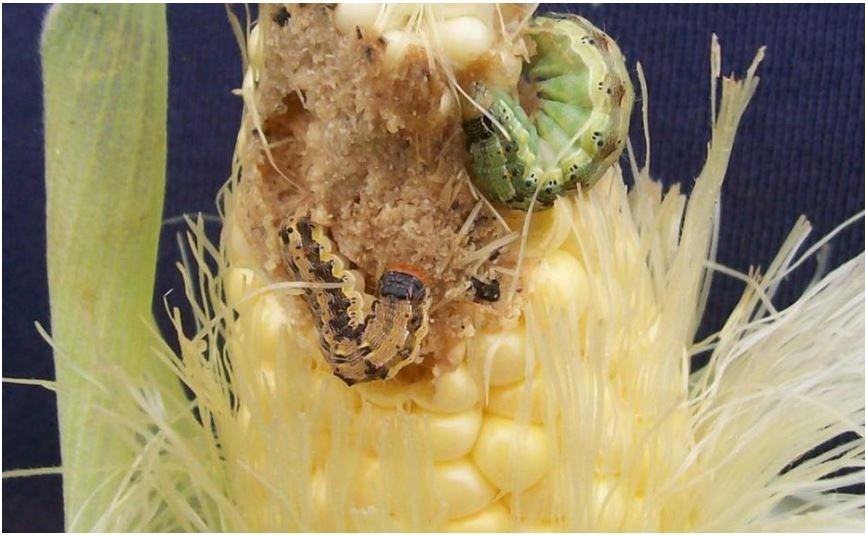Pesticides are used by farmers to manage agricultural pests. However, pesticide-resistant insects frequently become immune to their toxins. A method for using genomics to detect and identify new resistance to particular toxins early on, well before it becomes a widespread issue, has been developed and successfully tested by researchers at the University of Maryland. Through the study, farmers will be able to reduce resistance and extend the useful life of pest management tools.
 Corn earworms feeding on an ear of sweetcorn. Image Credit: Dr.Galen Dively
Corn earworms feeding on an ear of sweetcorn. Image Credit: Dr.Galen Dively
The research was published on March 18th, 2024, in the Proceedings of the National Academies of Science.
Global food security and protection of public health rely on the availability of effective strategies to manage pests, but as it currently stands, the evolution of resistance across many pests of agricultural and public health importance is outpacing the rate at which we can discover new technologies to manage them. I am really excited about this study, because we are developing the framework for use of genomic approaches to monitor and manage resistance in any system.”
Megan Fritz, Study Senior Author and Associate Professor, Entomology, University of Maryland
For many years, farmers have grown corn that has been developed to contain natural chemicals that are safe for people but harmful to many pests, including the ravenous, crop-damaging caterpillar known as corn earworm. However, corn earworm has developed widespread resistance to several of these toxins, and farmers are unsure how to extend the practicality of the remaining toxins, owing to the difficulty of monitoring and detecting rising resistance before it is too late.
Fritz and colleagues demonstrated in an earlier study from 2021 that indications of resistance in corn earworms could be found using genomic tools four years before the insect could cause significant crop failure in managed crops. However, the methods employed by the team required two different experiments to separate the genomic changes linked to toxin resistance from those associated with other factors like environmental changes, they were better suited for research than broad application in agriculture.
In this study, the scientists adjusted their approach and pinpointed the precise genetic alterations in charge of resistance to several Bt toxin types. The Cry1Ab and Cry1F toxins, two of the three Bt toxins, are no longer as effective against corn earworms. The only Bt toxin that is still effective against corn earworm is the third toxin, also referred to as Vip3A.
The researchers sequenced the genomes of corn earworms taken from corn that expressed individual Cry toxins and compared them to those taken from non-toxin-expressing corn to test their new approach.
They discovered that genomic indications of resistance to toxins might be detected after only one generation of exposure. The researchers also found changes in certain genes that might explain toxin resistance. These genes encode digestive enzymes that chop Cry toxins into smaller pieces, perhaps preventing them from harming caterpillars.
Fritz and colleagues then identified changes in corn earworm collected from corn expressing the Vip3A toxin using the same genome sequencing method. They not only identified early warning indicators of Vip3A resistance, but also explained how common tactics for resistance prevention contribute to the development of Vip3A resistance.
To provide a haven for corn earworms from Bt toxins, non-Bt expressing corn is frequently planted next to Bt corn. Corn earworms fed with non-Bt corn were thought to remain susceptible to Vip3A because they would not be exposed to it. In contrast to resistant corn earworm, susceptible corn earworm would be able to endure and proliferate. In a population of corn earworms, the theory is that this tactic prevents or delays the development of resistance.
Fritz’s team discovered that non-Bt corn sown among four rows of Bt corn expresses some Bt toxins, such as Vip3A. This is the result of Bt pollen landing on non-Bt corn due to wind pollination. Certain non-Bt kernels become “contaminated” as they develop and express the Vip3A toxin.
According to the team’s findings, interplanting non-Bt corn with Bt corn in an attempt to prevent resistance—a practice known as “seed-blended refuge”—might actually expose caterpillars to low concentrations of Vip3A and accelerate the emergence of Vip3A resistance.
According to Fritz’s study, implementing new tactics for planting Bt corn and monitoring resistance might be necessary for effective resistance prevention. This study provides a framework for genomic testing to track future resistance prevention efforts.